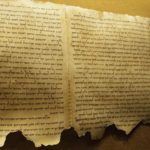 More than 60 years after their discovery, Israeli experts have finally figured out the contents of one of the last two undeciphered fragments of the Dead Sea Scrolls.
More than 60 years after their discovery, Israeli experts have finally figured out the contents of one of the last two undeciphered fragments of the Dead Sea Scrolls.
Scientists at Haifa University reconstructed 60 tiny fragments that were part of six different scrolls.
What they discovered after they put it all together was a unique 364-day calendar used by a Jewish sect living during the Second Temple time.
“Most Jews used a calendar that is similar to the one used today,” Dr. Eshbal Ratzon of Haifa University told Israel’s Haaretz newspaper. “The sect used a calendar that is almost based on a solar year, comprising 364 days.”
Notes on the fragments show the sect even gave names to the days marking the four seasons. The days were referred to by the word “Tekufah” which in Hebrew means “period.”
“This term is familiar from the later Rabbinical literature and from mosaics dating to the Talmudic period, and we could have assumed that it would also be used with this meaning in the scrolls, but this is the first time it has been revealed,” remarked professor Jonatan Ben-Dov, who helped Ratzon decipher the ancient texts.
Some of the fragments were so tiny, measuring approximately 0.155 sq inches.
“This is the most important archaeological find ever made in Israel,” Ratzon said. “This is literature from the Second Temple period, and that’s rare.”
The scrolls, which date back almost 2,000 years, were part of 900 ancient Jewish manuscripts discovered in the Qumran caves near the Dead Sea between 1947 and 1956.
Ratzon and fellow scientist Ben-Dov, who teaches at the Bible Department at Haifa University, said they also discovered fascinating comments in the margins of the scrolls.
“What’s nice is that these comments were hints that helped me figure out the puzzle,” exclaimed Ratzon.
He believes the notes were made by a scribe as changes were being made to the ancient documents.
Razton added that the scribe’s annotations “showed me how to assemble the scroll”.
Ratson and Ben-Dov said they spent over a year reassembling the 60 fragments, most of which were written in Hebrew.
Now, only one more known scroll remains untranslated.















